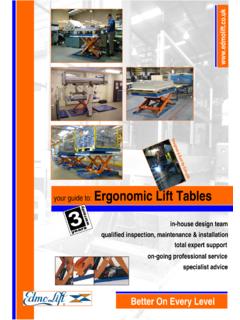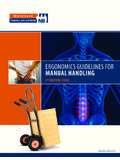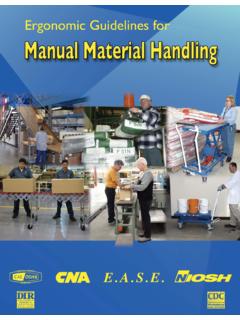Transcription of HSL/2001/13 Human Factors Group
1 Broad Lane, Sheffield, S3 7 HQTelephone: +44 (0)114 289 2000 Facsimile: +44 (0)114 289 2500 Crown copyright 2001 Musculoskeletal problems in bricklayers,carpenters and plasterers: Literature review andresults of site visitsHSL/2001/13 Human Factors GroupAdele Reid, Andrew Pinder and Simon MonningtonDr ADJ PinderProject Leader:SummaryThis project was a preliminary ergonomic investigation of the Factors that can lead tomusculoskeletal disorders in construction To carry out a comprehensive literature review of epidemiological and ergonomicstudies of musculoskeletal complaints among bricklayers, carpenters and To carry out site visits to observe and discuss the work undertaken by plasterers,carpenters and bricklayers to identify how the work affects the risks ofmusculoskeletal disorders in these Findings1. Construction is a high risk industry for musculoskeletal Existing HSE data on the prevalence of musculoskeletal trouble shows that whilethere is considerable variation between trades in the levels of problems reported indifferent parts of the body, there is no distinct separation of any one trade from the restof the industry.
2 Instead, the parts of the body worst affected appear to Overall, the published scientific literature concentrates on disorders of the low back,the upper limb, and the There is extensive European literature on brick and block laying. The precisepractices carried out depend upon the styles of building fashionable in the particularculture. Bricklaying is seen as strenuous and a high risk task for musculoskeletaldisorders, particularly of the low back and Carpentry comprises a wide variety of sub-trades and tasks. The allocation of jobs tothe trade appears to be partly culturally determined with dry lining work beingdescribed as a plastering task in the UK and a carpenter s task in the USA. Theergonomics literature on carpentry and epidemiology of carpenters is fairly The ergonomics literature on plastering tasks is restricted to recent work on is no literature on wet plastering nor on floor screeding.
3 Dry lining is seen as aheavy and high risk task due to the need for the manual handling of large and heavysheets of Site observations of plasterers showed that it is physically demanding involvingmanual handling of heavy materials and also requiring reach, flexibility to work in avariety of awkward postures, including on raised platforms, and also Site observations of carpenters showed that tasks can vary widely. The self-perceptionof carpenters working indoors appeared to be that they were concerned with generalsafety issues rather than musculoskeletal issues specifically, suggesting they did notsee their tasks as particularly straining on the musculoskeletal Site observations of bricklayers showed a variety of problems, especially concernedwith handling of heavy materials. Issues of lack of space, poor work planning,variation in height and working in awkward postures were identified.
4 The weight ofconcrete blocks is clearly an important issue. As with plastering, strength andflexibility are A recurring theme was that the commercial pressures on workers force them to workas quickly as possible and therefore they risk compromising Recommendations1. Those involved in designing buildings, and planning and managing their constructionneed to take into account the risks to musculoskeletal health of the different availableconstruction methods, and to plan the structure and the construction processes in wayswhich allow these risks to be reduced so far as is reasonably There is a need for the construction industry to make more extensive use of the aidsthat are already available to reduce the risks of manual handling and postural stress There is a need for further scientific work to be carried out to examine the ergonomicrisk Factors of wet plastering and floor is responsible for making ergonomics improvements in theconstruction industry?
5 Of literature of musculoskeletal disorders in Posture adopted by of hand held / snagging building of musculoskeletal disorders in and biomechanical Provision of hand grips on Reducing block size and Job of musculoskeletal disorders in HSE data on WMSDs in the construction observational methodologies for studying ergonomicrisk Factors in Other risk Psychosocial Organisational Physical work load and exposure to lifting / Smoking / alcohol risk Factors for of a previous history of medical scale of the disorders as a problem in the Recommendations for further Type of action most likely to be Scope for taking Recommendations for further Type of action most likely to be Scope for taking Recommendations for further Type of action most likely to be Scope for taking future directions for HSE research on WMSDs inconstruction Laying of brick / block Bricklayers laying concrete Parapet coping Indoor carpentry Skim Traditional two coat wet of site handling of controls for ergonomic risk is the future of ergonomics in building and construction?
6 List of Tables17 Table of postures and weightings in the ergonomicwalkthrough checklist developed by Bhattacharya et al.(1997)..7 Table trades NMQ data were collected of Figures47 Figure 36. Carpenter receiving pieces of timber being lowered from topof flyover 35. Carpenter removing formwork from top of flyover pillar andlowering it to the 34. Plasterer polishing skim coat of 33. Plasterer polishing skim coat of 32. Skim coating of wall near floor 31. Skim coating of top of 30. Pouring of mixed plaster onto 29. Hand mixing of plaster with 28. Paddle used for hand mixing of 27. Addition of plaster to 26. Collection of water from supply outside 25. Screw fixing of 24. Screw fixing of 23. Nailing of 22. Breaking of plasterboard / scoring of rear surface afterscoring face surface with a sharp 21. Scoring of 20. Scoring of 19. Supply of 18. Smoothing of roughly plastered 17.
7 Tool for smoothing 16. Plastering of wall above 15. Plastering of wall near floor 14. a) Carrying plaster on hawk; b) Plastering of wall near 13. a) Mixing plaster with an electric stirrer; b) Shovelling plasterfrom mixing tub to 12. a) Supply of 25 kg sacks of plaster; b) Carrying 25 kg sack 11. An air operated lifting 10. Hook lifting 9. Modification of 8. Plasterboard 7. Drill 6. Height adjustable 5. Methods of lifting sheets of plasterboard identified by Panand Chiou (1999)..18 Figure 4. Posture classification in the ergonomic walkthrough checklistdeveloped by Bhattacharya et al. (1997)..10 Figure 3. Prevalence of disability within the previous 12 months due tomusculoskeletal trouble ..9 Figure 2. Prevalence of musculoskeletal trouble within the previous 1. Prevalence of musculoskeletal trouble within the previous12 73. Laying concrete blocks in a trench with restricted foot 72.
8 Laying concrete blocks in a trench with restricted foot 71. Laying concrete blocks in a trench with restricted foot 70. Positioning a concrete 69. Laying a concrete 68. Carrying a concrete 67. Handling concrete 66. Handling concrete 65. Laying concrete 64. Laying 63. Cutting a) a brick and b) a concrete 62. Tapping a brick into 61. a) Spreading a bed of mortar onto a layer of bricks; b) Layinga 60. a) Carrying a mortar board; b) Picking up mortar with 59. Carrying and putting down a mortar 58. a) Pouring mortar onto board on ground; b) Carrying 57. a) Shovelling mortar from a plastic tub; b) carrying 56. Elevator for lifting concrete blocks to level 55. Building workers using a sledge hammer and long wrench tofix structural steel work in 54. Building worker pulling a pallet truck of concrete 53. Bricklayer lifting a hollow concrete block to approximatelyhead 52.
9 Bricklayer a) positioning and b) adjusting the position of a 26kg concrete 51. Bricklayer a) lifting and b) carrying 26 kg concrete 50. Handling of cut half of 140 mm concrete 49. Handling of 140 mm concrete 48. Decorative cast stone pieces for external 47. Moving coping stones across pallet to bring them closer tothe block and tackle fixed to the 46. Attempts to bring the pallet truck up two 45. Attempts to bring the pallet truck over a bump in the 44. Attempts to bring pallet truck over a bump in the 43. a) Plank being placed to act as ramp for pallet truck; b) pallettruck with coping stones being pulled up 42. a) Coping stones being moved on a pallet truck; b) Metalrods being moved out of the way of the pallet 41. Carpenters hanging a door with pre-fitted 40. Carpenters fitting forms for the base of a concrete 39. Carpenter handling plywood sheets for the base of anaccess platform on a flyover 38.
10 Top of flyover pillar prior to carpenters fitting 37. Flyover pillar with formwork at disorders as a problem in the construction industryAccording to a number of epidemiological and ergonomic studies, the construction industry isin the top three occupations for work-related musculoskeletal disorders (WMSDs), along withthe manufacturing and meat processing industries. WMSDs are clinical and sub-clinicalconditions affecting the musculoskeletal system of the body, , the muscles, tendons, nervesand bones. Symptoms usually include discomfort, pain, numbness or tingling in a bodyregion. Disorders of the bone are typically bruises, micro-fractures, cracks or are associated with four main risk Factors , undesirable force, duration, repetition and theadoption of static and awkward postures. Research suggests that both extreme work posturesand static work postures contribute to the occurrence of low back and musculoskeletalsymptoms.

















